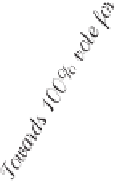Information Technology Reference
In-Depth Information
Box 7.1
The electoral triangle
An equilateral triangle can show the composition of the votes of three parties,
among a number of constituencies, very clearly. Position (
x,y
) on the trian-
gle is calculated from the Conservative (
C
), Labour (
L
) and Liberal/Alliance
(
A
) proportions of the vote as follows:
C
+
L
+
A
=
1
−
L
+
2
, y
=
A
√
3
1
x
=
2
The position on the equilateral triangle then gives the share of the votes in any
one constituency and the distribution of them all can be seen simultaneously.
Once the space in which the graph is to lie has been determined, there remains
only the relatively simple decision to take on the way in which the data should be
drawn. Many different choices can be made. A featureless line is usual, but bar
charts and histograms can depict particularly simple cases (rectangles instead of
line segments). Scatter plots show the observations upon which the line is based,
and can be arranged to show multivariate information. Repeated rendering of
convex hulls (or 'kernels') around a set of points produces something akin to a
contour diagram.
7
7
This technique is very similar to Kriging: http://en.wikipedia.org/wiki/Daniel_Gerhardus_Krige.


















Search WWH ::

Custom Search